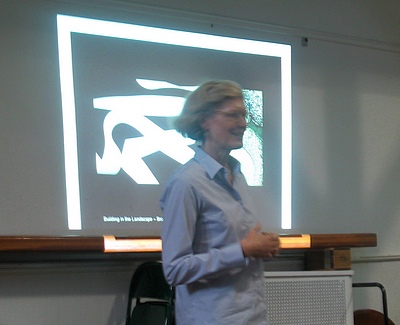
Yesterday (Wednesday) evening the Fieldhouse road show continued in Willowtown, at a meeting arranged by the Willowtown Association and hosted by their President, Ben Bankson. The opening presentation was similar to that at St. Francis on Monday, except that Fieldhouse Executive Director Greg Brooks stressed even more–no doubt anticipating the questions he knew would come–that this was a meeting to hear concerns and get information from the community, not to offer answers. Also, the design portion of the presentation was handled by Jean Phifer (photo) of Thomas Phifer and Partners, instead of Greg Smith, of that firm.
Kate Collignon, of consultant HR&A Advisors, Inc., fielded the first volley of questions. The opening question was, what is the expected daily usage of the Fieldhouse? Ms. Collignon said there is no specific expectation at present; this will have to await information from local schools and other community organizations about their needs and desires. The next question was: How, then, can projections of traffic be made for the supplemental Environmental Impact Statement without full information about usage? Joralemon Street resident Frank Ciaccio said the issue of transportation needed to be addressed first. Others quickly seconded this, some noting that Joralemon between Hicks and Furman is already overburdened with auto (especially livery cab) traffic seeking a shortcut to the BQE. There was general agreement that the best solution to this problem was to block entrance to Furman Street from Joralemon. It was suggested that this could be done with retractable bollards that could be lowered to allow passage of emergency vehicles when needed. However, this would require assent of the City’s Department of Transportation, as well, perhaps, of other agencies.
Parking was also a concern. Some residents noted that parking in Willowtown had become more difficult since the playground on Pier 6 had opened, and anticipated its being much worse with the Fieldhouse. Ms. Collignon noted that one of the ways to encourage people to use mass transit instead of cars was to provide jitney service from nearby subway stations. Mr. Ciaccio suggested opening a tunnel from the Clark Street subway platform to Furman Street, which he said could be done at minimal cost.
One resident, noting Ms. Phifer’s emphasis on the lightness of her firm’s buildings, said she had spent a winter fostering a family of abandoned dogs in the the then derelict area where the Fieldhouse is to be constructed. She said the winter time she spent there showed the site to be extremely cold and windy, and she hoped that the architects, who were proud of their “light” buildings, would design something strong enough to withstand the weather. Ms. Phifer assured her that they would.
Source: Brooklyn Heights Blog
http://brooklynheightsblog.com/archives/43232

